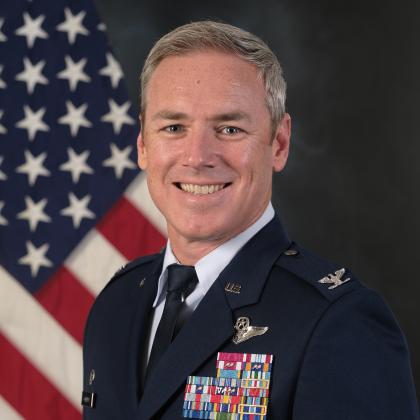Capstone Event Propels C3 and the Future of ABMS
This article is a first in a series examining the U.S. Air Force's journey to field joint all-domain command and control solutions and create its vision of a Battle Network.
The U.S. Air Force’s Joint All Domain Command and Control (JADC2) laboratory, the Shadow Operations Center-Nellis (ShOC-N), conducted a key event in December to consider new command and control (C2) and battle management technologies. With a new Program Executive Office ramping up to acquire industry Advanced Battle Management System (ABMS) capabilities, the event featured several new Air Force-created solutions, such as Edge Connect, the ABMS Model for Battle Management, and an instrumentation database, as well as industry-provided current and emerging ABMS and C2 solutions, explained Col. Frederick Coleman, USAF, commander, 505th Command and Control Wing, Hurlburt Field, Florida and Lt. Col. John Ohlund, USAF, commander of the ShOC-N.
The ShOC-N is the 805th Combat Training Squadron at Nellis Air Force Base, Nevada, which is one of four squadrons under the 505th.
As the designated battle lab for ABMS—the Air Force’s service contribution to JADC2—as well as the Joint Chiefs of Staff’s designation to be the service’s JADC2 battle lab, the ShOC-N has expanded into its role well and is a great venue to test things from both a digital and a human perspective, according to Col. Coleman. The ShOC-N hosted about 420 people for the December event, which will be referred to as a capstone event when the squadron hosts it again in June at Nellis.
“They built an environment in which it's easy to come in and plug in new technology and test and experiment with it,” he said. “The event itself I’d say had three primary goals, and … it really was squadron-led, so my role as the wing commander was simply just to help facilitate and enable the squadron to pull this thing off. The first [goal] was to continue our work with the ABMS CFT [CrossFunctional Team] to model battle management functions. They've taken a systems engineering approach to battle management and really have broken it down into the smallest functions possible to figure out what can be automated and where you can speed up battle management.”
The Air Force’s new ABMS acquisition organization, the Program Executive Office Command, Control, Communications and Battle Management (PEO C3BM), led by Gen. Luke Cropsey—who was appointed to lead the PEO last September—has a team embedded in the ShOC-N. They developed Edge Connect, a key tool for supporting C2 and ABMS and tested it at the ShOC-N event. It enabled the service to examine ABMS-related industry solutions, amongst other things.
“They have prototype called Edge Connect, Col. Ohlund noted. “They've been iterating improvements for a while. They brought out the prototype to Valiant Shield in June and it was fully functioning at Project Convergence in October and November. C3BM came out, gave us some Edge Connect kits to provide the data connectivity. We put together a few tents and a few prototypes outside of our facility, and we thought that also went really well, especially with the Edge Connect providing data connectivity. And it is great to theorize what the concept would be if you have a small suitcase of Edge Connect and if the Air Force wanted to buy one of the [industry] prototypes, [they could look at] all of the basic questions of how would this work, and the pros and cons.”

More broadly, Edge Connect could also be applied as a data transport solution for agile combat employment (ACE), in addition to C2 and other tactical operations, the ShOC-N commander shared.
In addition, the event featured the first real-world application of the ABMS Model for Battle Management. The ABMS CFT, led by Brig. Gen. Jeffery Valenzia, spent the last year developing the model. The platform maps all C2 subfunctions, showing the individual steps that go into the Air Force’s current C2 functions for their existing systems.
The model is allowing the Air Force to have a “very precise” picture of battle management, Col. Jonathan “Beep” Zall, who is leading the model’s development in the CFT, explained last September during the Air and Space Force Association conference.
At the ShOC-N event, the CFT tested the first subfunction of version 1.0 of the ABMS model, referred to as Match Effect, 2.X.09, plugging into the center’s extensive test bed infrastructure and proving a baseline for how humans and the model performed ABMS and C2 functions.
“Col. Beep Zall, he's really the guy behind the systems engineering of battle management,” Col. Coleman shared. “What it allows us to do is first, continue to break down that model and identify the functions within that model. And then it allows us to start to measure and form a baseline measurement of each of those functions. So, ‘this function on average takes 12 seconds, this function on average takes this many people,’ and so we can quantitatively measure how we do [C2] today, so that as we bring in the next systems and the next techniques and procedures, we have something to compare it against.”
The ShOC-N event also featured the unveiling and testing of a new instrumentation dashboard created by the 805th to specifically measure the digital and human C2 performance.
“We've got a number of software engineers assigned to the 805th Combat Training Squadron and over the past year they've been working on building an instrumentation dashboard,” Col. Coleman stated. “And what that does is it allows us to quantitatively measure performance of humans and systems and compare them to each other. And we just didn't have an instrumentation capability before. We do now, and so, the second goal of the event was to use our instrumentation dashboard to see how we're able to baseline and measure battle management functions."
The Air Force’s funding for a software team to be within the ShOC-N has proven to be “a game changer,” Col. Ohlund added.

The first [goal] was to continue our work with the ABMS CFT [cross functional team] to model battle management functions.
To track human behavior in a tactical C2 environment, one of the main measurements used with the dashboard was time, the commander of the 805th explained.
“When you talk software, it's really hard to determine which piece of software is better,” Col. Coleman said. “What we wanted to do is find a way to capture data and do it in a way that wasn't subjective but instead was objective. And so, you have to go human by human, and see ‘Hey, this human did this thing 10 times on average, and it took them this many seconds.’ When we put this new tool in, the human did the same exact function, but they did it in more or less seconds. Time is the easiest quantifiable measure. The instrumentation dashboard was measuring our baseline of what is our ability today, using our existing systems, how long does it take us.”
Moreover, the event highlighted industry ABMS and C2 capabilities, with the ShOC-N hosting 129 businessmen and women on the last day of the event, allowing Air Force personnel from around the globe to converse and examine their industry prototypes in conjunction with the Air Force hardware and software solutions and infrastructure in the tactical environment.
“The third thing was to showcase different [industry] technologies that are available and exist today and provide a networking and collaboration opportunity for military industry partners,” Col. Coleman stated. “We did do testing and analysis with some of our tactical operation center (TOC) equipment, with TOC-light tents that were set up where we were able to use some new and emerging technology from industry to both capture current processes and then see how those processes look when we use the new systems.”
"“Industry has advantages with their product lines and their ability to scale; our leadership sees the value and opportunity to partner industry with a venue that ShOC-N can provide,” noted Col. Ohlund. “When industry, acquisition, developers and operators are all iterating together face-to-face on a new product, it’s amazing to see how quick improvements are realized.”
To design the event, the leaders solicited input from key Air Force stakeholders, including the Air Combat Command (ACC) and the Pacific Air Forces (PACAF), who provided real-world issues.
“We started planning back in June and we asked our partners and our major commands, PACAF and ACC, if we can answer an RFI [request for information] or if we can help them take a look at a particular prototype,” Col. Ohlund noted. “They gave us some questions to look at and [from that] we designed a scenario.”

For PACAF, they demonstrated operational C2 prototypes, with industry representatives showing their technologies as well as Air Force exhibitions of in-house made software solutions, including a key software application suite from the Kessel Run Software Factory and additional C2 software used by other air operation centers.
“Kessel Run is preparing one of the Air Force's up and coming software tools,” Col. Ohlund said. “It's a suite of applications and they're working through its development and fielding parts of the product. But in lieu of Kessel Run, there's other operational C2 centers that are using different software. PACAF asked us to bring a couple of prototypes together and so that way, they can see them all at one location and let the PACAF users ‘smash the buttons,’ if you will, and give feedback to the company: ‘Hey, could it do this?’ Or ‘Hey, could it do that?’ That's really valuable for industry to hear that warfighter feedback.”
Meanwhile, the ACC’s request was to see hardware related to tactical operations. “We also had a TOC question from ACC,” the ShOC-N leader explained. “They wanted us to do some hardware prototyping. The same kind of thing, have companies come out, bring their best prototypes out, let users ‘smash the buttons.’ And then also for ACC just to get some basic feedback, influencing what they call a rapid prototyping requirements document, an RPRD. We were happy to share some of the feedback from the users and give that back to ACC and happy to answer some of their questions.”
From the event, the leaders have a clear missive. “What we're seeing overall, is that our processes today are far too manual,” Col. Coleman said. “I could give dozens of examples in which our processes today are essentially interrupted by human interface. We've got to get out of the business of going digital, human-digital. And we've got to get into the business of going digital-digital. The first thing that the CFT model does is it helps us identify where the humans in the loop really shouldn't be. That's one of the big takeaways from the model. And then what the instrumentation allows us to do is when we do have new technology, and a lot of it exists, we plug it in there at the ShOC-N, and that helps us to prove, to quantify, to measure the ability of how much can we speed up this process when we take the human out of the loop.”
“From a squadron perspective, I think it was wildly successful,” Col. Ohlund said.
The leaders are already gearing up for the follow-on June capstone event and more in the future to discern the ABMS and C2 tools that the Air Force needs. “Our intent is to repeat this at least annually and have a capstone event like this where we bring the best of the best together and continue to try to connect them and show capabilities and identify gaps and seams,” the 805th commander said.

We asked our partners and our major commands, Pacific Air Forces and Air Combat Command, if we can answer an RFI [request for information] or if we can help them take a look at a particular prototype.





Comments